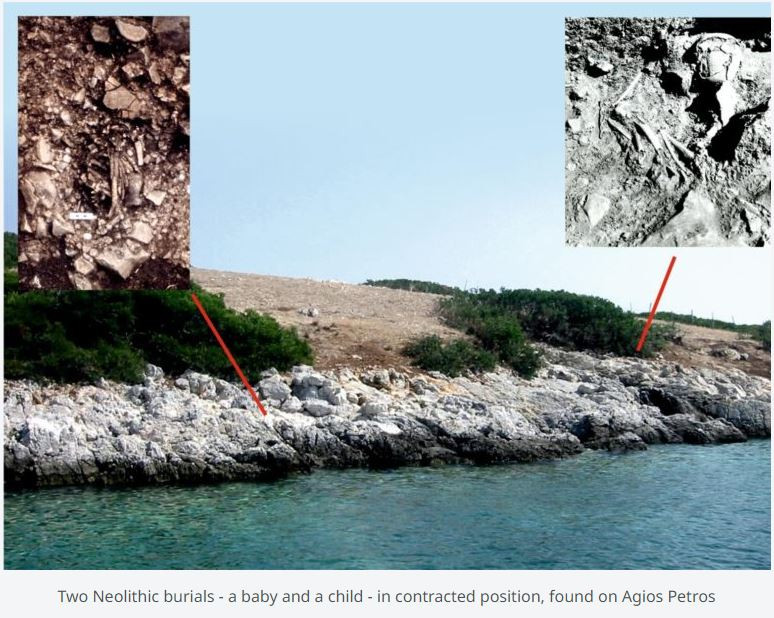Dozens of families inhabited the islet of Agios Petros around the end of the 7th millennium (6100 BC) and for about 1,000 years
Once a part of Kyra Panagia, the uninhabited islet north of Alonissos, the small islet of Agios Petros has “christened” not only the bay it dominates, but also an entire culture.
Dozens of families – farmers, herders and fishermen – settled permanently in the area around the end of the 7th millennium (6100 BC) and inhabited the islet for about 1,000 years.
At the time the settlement was developed, the islet of Agios Petros was connected to Kyra Panagia through a peninsula, which today has been submerged, as has part of the Neolithic settlement.
With the rise of the sea level over the millennia, today most of the settlement is 5 to 7 m below sea level.
How the “occupants” of the sunken island lived
“The fact that the marine settlement of Agios Petros is preserved to this day at the bottom of the Aegean several thousand years after its foundation, is a special case of an archaeological site, since it allows us to raise and investigate archaeologically a number of important issues concerning history of the island habitation in the Aegean, the natural environment that the first islanders saw”, says Nikos Efstratiou, professor of Prehistoric Archeology at AUTH, head of the land and sea research at the site where the oldest – known – sunken settlement in the Aegean developed .
During the excavations on the islet, architectural elements have been identified (e.g. stone rectangular and arched buildings, two children’s burials in natural rock cavities (next photo), stone piles, walls, etc.), mobile finds, such as tools from flint, obsidian and animal bones, clay textile weights, food remains from various animals, birds, fish and oysters, as well as anthropomorphic figurines and written ceramic sherds, which also give the designation “St. Peter’s Culture”.
“Perhaps the most interesting archaeological evidence available to us (ceramics, figurines, obsidian) is that it was not an isolated community but rather one that had cultural contacts with other and often more distant geographical areas such as the southern Aegean, the Thessaly, the Balkans and Anatolia. After all, archaeological research today accepts that the arrival of agricultural groups from Anatolia to Greece, to the other islands of the Aegean such as Crete, and later their movement to the Balkans and Europe, also took place by sea.
The prehistoric settlement of Agios Petros was discovered for the first time in the 60s by the archaeologist Dimitris Theoharis, then the Antiquities Commissioner of Thessaly. Since the 1980s, the head of research has been the interlocutor of APE-MPE, N. Efstratiou, who carried out the first underwater research in the area, in collaboration with the well-known oceanographer NC Flemming and the team of archaeologist-divers from the University of Cambridge. Today the research, conducted by the AUTH and the Ephorate of Marine Antiquities, is part of a promising five-year program.
“Imagine through archeology that we can talk about the daily life of these first farming communities, their way of life, their occupations, as well as aspects of their behavior, their relationships and contacts with other neighboring island or continental groups. Everything that archaeological research tries to approach through all kinds of humble material remains saved by the soil, on land or at sea.
The idea that archeology is the only science that can open a window into the distant past and introduce us to a way of life that has been irretrievably lost is really appealing as well as challenging. Not that this is an easy effort, without difficulties, especially when through the findings we try to talk about behaviors and personal or collective choices”.
Source: Skai
I have worked as a journalist for over 10 years, and my work has been featured on many different news websites. I am also an author, and my work has been published in several books. I specialize in opinion writing, and I often write about current events and controversial topics. I am a very well-rounded writer, and I have a lot of experience in different areas of journalism. I am a very hard worker, and I am always willing to put in the extra effort to get the job done.











